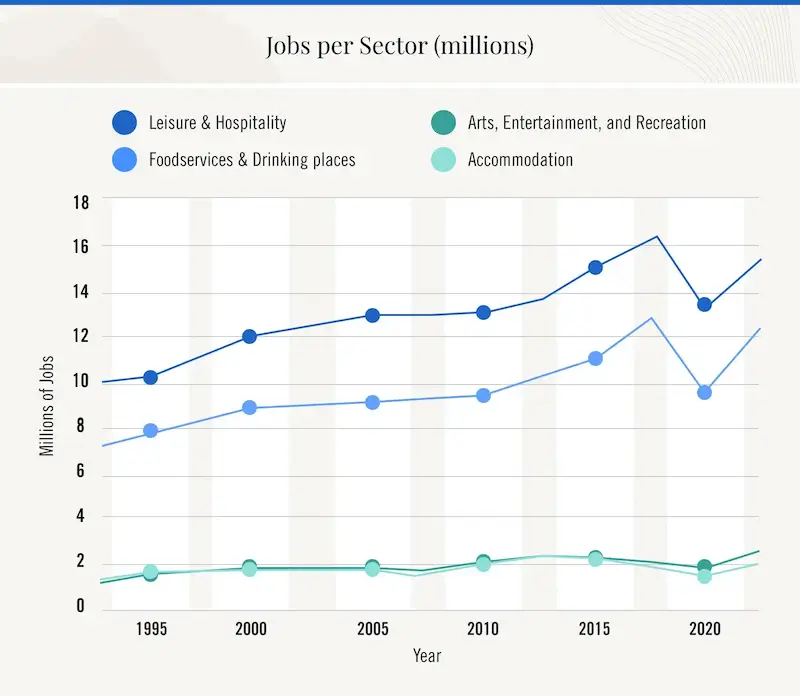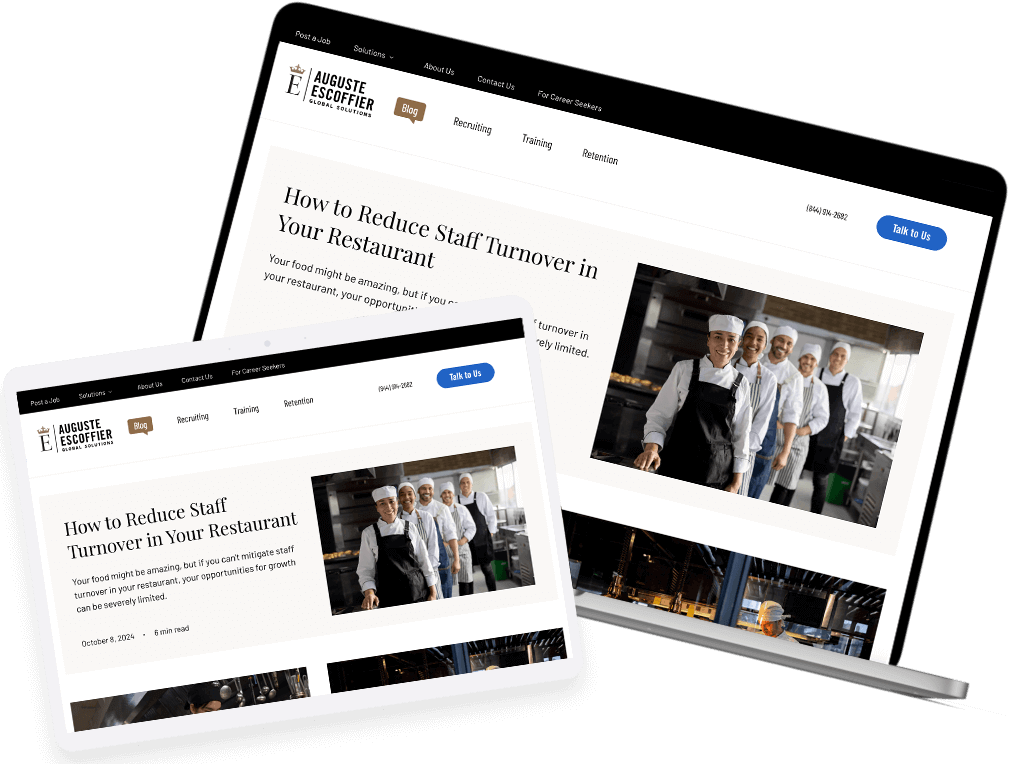
2025 Culinary Industry Hiring & Retention Trends
The staffing shortage is cooling—yet a competitive landscape presents challenges and opportunities for operators. Get up-to-date insights on the latest industry trends in hiring and retention.
For the restaurant and hospitality industry, the story of the last few years has been post-pandemic recovery. After devastating job losses, the sector has fought its way back; as of late 2024 and early 2025, however, employment has officially returned to pre-pandemic levels and continues to grow.
Throughout this recovery, operators focused on “getting back to normal.” Data suggest that this phase is now complete. The industry has achieved a “new normal” that brings both opportunities and challenges different from the pre-pandemic environment.
The question facing businesses today is no longer how to recover, but how to navigate this transformed landscape. What does this new normal look like, where does it go from here—and how can operators adapt to develop a stronger, more engaged workforce? We took a look at the numbers, which reveal both promising developments and persistent challenges.
The New Normal – Amid Recovery, Hiring Challenges Persist
Overall leisure and hospitality employment has fully recovered from pandemic losses. According to the Federal Reserve Bank of St. Louis, as of November 2024, employment surpassed the February 2020 peak of 16.89 million jobs, reaching 16.99 million by April 2025. 1

(source)
The sector is projected to add 822,700 new jobs by 2033, indicating long-term growth beyond the recovery phase.2 However, this recovery is uneven across different segments of the industry.
Hotel employment remains about 10% below pre-pandemic staffing levels according to the American Hotel and Lodging Association (AHLA),3 while restaurant employment has rebounded faster—as of April 2024, restaurant jobs were 0.3% above February 2020 levels according to data from the National Restaurant Association (NRA).4 This faster restaurant growth may be due to stronger consumer demand and quicker return of foot traffic compared to business travel and hospitality services.
Ongoing Staffing Shortages
Despite the overall recovery, staffing challenges persist across the industry. The AHLA has found that 65% of U.S. hotels report ongoing labor shortages, even after raising wages and offering additional perks. While this represents an improvement from 76% of hotels reporting the same in May 2024, the problem remains widespread. Nine percent of hotels described themselves as “severely understaffed” at year-end 2024, down from 13% the previous May.5
On the restaurant side, 59% of operators said they had positions that were hard to fill; this was down from 70% in 2023.6
What Percentage of Hotels and Restaurants are Still Struggling to Fill Positions?
| Hotels | Restaurants | ||
| As of… | % | As of… | % |
| 2024 | 65% | 2024 | 59% |
| Early 2024 | 76% | 2023 | 70% |

On average, 71% of hotels reported openings they couldn’t fill despite active recruiting efforts, with the typical hotel trying to fill six to seven open positions. The most difficult positions to fill were housekeeping (38% ) and front desk (26%), followed by culinary (14%) and maintenance (13%).
For restaurants, chef/cook positions were most difficult to fill, with 59% of operators reporting difficulty hiring. Manager and kitchen support positions were next at 54% each, while 52% struggled with front-of-house/customer service positions.
What Percentage of Operators Report Difficulty Hiring These Positions?
| Hotels | Restaurants | ||
| Position | % | Position | % |
| Housekeeping | 38% | Chef/Cook | 59% |
| Front Desk | 26% | Manager | 54% |
| Culinary | 14% | Kitchen Support | 54% |
| Maintenance | 13% | FOH/Customer Service | 52% |
Restaurant hiring has remained high in early 2025 according to the NRA, with approximately a 5.1% monthly hiring rate, though this represents a slight slowdown from the 5.6% rate maintained through much of 2024. This recent hiring slowdown isn’t attributed to layoffs, but rather to ongoing difficulty finding qualified applicants. The shallow hiring pool means the market remains friendly to job seekers.7
The recovery varies significantly by geography. The NRA has also reported that restaurant employment is significantly above pre-pandemic levels in fast-growing states like Idaho (+13%), Utah (+12%), and Montana (+11%).
However, 21 states and D.C. have still not recovered all restaurant jobs lost during the pandemic—including Illinois, Maryland, Vermont, and Massachusetts. The pattern shows slower recovery in urban markets reliant on business travel and office workers, while suburban and touristic areas are seeing faster growth.
As Ever, Industry Turnover Is High
Hospitality consistently has the highest turnover of any U.S. sector; even in 2018, well before the pandemic, annual turnover was around 75%.8 During 2021-2022, monthly quit rates peaked at 5.8% in accommodation and food services—double the national average.9
As of 2024, quit rates in hospitality had eased to 3.9%—not only nearly two points lower than the 2021-2022 peak of 5.8%, but also lower than in 2019 (4.9%), suggesting the sector has stabilized. Even so, the quit rate remains the highest of any sector. The revolving door nature of the industry means even strong hiring can often only keep up with churn.
Between January-April 2024, nearly 3 million hospitality workers quit—204% the national average quit rate.10 However, hospitality hiring remains high enough to offset most quits, with 1.05 million hired in January 2024 versus 781,000 quits.11
Average Annual Quit Rate, by Industry
| Sector | 2020 | 2021 | 2022 | 2023 | 2024 |
| Leisure and hospitality | 4.1 | 5.5 | 5.4 | 4.7 | 3.9 |
| Retail trade | 3.2 | 4.2 | 3.9 | 3.3 | 2.7 |
| Durable goods manufacturing | 1.4 | 2.1 | 2.0 | 1.6 | 1.5 |
| Financial activities | 1.3 | 1.5 | 1.7 | 1.4 | 1.3 |
| Professional and business services | 2.7 | 3.4 | 3.3 | 2.6 | 2.4 |
(source)
Retention Remains a Perennial Challenge
The staffing shortage isn’t just about finding quality workers—it’s about keeping them on the job. Seventy-seven percent of restaurant operators report recruitment and retention are their top concerns,12 with 54% of restaurants struggling to fill management and skilled back-of-house roles like cooks and chefs.13 This highlights a skills gap—as well as an opportunity for job seekers to advance by upskilling for in-demand positions.
Understanding why workers leave reveals the underlying structural challenges. Turnover is often driven by burnout, inflexible schedules, low wages, and limited advancement opportunities.14 Hospitality jobs are typically in-person, high-stress, and low-paid—factors that make them more vulnerable to quits than other sectors.15
The demographic reality compounds this challenge. Case in point: younger workers in particular often use hospitality as a temporary stepping stone rather than a long-term career path—yet young workers also make up a huge percentage of the workforce. 39.6% of restaurant workers are under the age of 25 (compared to 12.9% of the total workforce), and fully 60% are under the age of 35 (compared to 35% of the total workforce).16
Age of restaurant and foodservice workforce compared with the broader labor pool
| Age Group | Restaurant Industry | Broader Workforce |
| 16 to 17 | 9.1% | 1.3% |
| 18 to 24 | 30.5% | 11.6% |
| 25 to 34 | 20.4% | 22.1% |
| 35 to 44 | 15.2% | 22.0% |
| 45 to 54 | 11.7% | 19.7% |
| 55 to 64 | 9.5% | 16.6% |
| 65 and up | 3.6% | 6.7% |
(source)
Younger workers also increasingly expect flexibility and purpose, not just a paycheck. According to the Society for Human Resource Management (SHRM), 22% of Baby Boomers said workplace culture was a factor in deciding whether to stay at a job, while 39% of Millennials and Gen Z said the same.17
This highlights the strong shift taking place among today’s workforce, in which businesses must be increasingly mindful of their employees’ experience and well-being in order to attract talent and keep them engaged.
Hiring and Retention Strategies in Today’s Landscape
Given these workforce expectations and the competitive talent market, operators are adapting their strategies across the entire employee lifecycle. This means innovating hiring tactics to attract quality candidates faster, offering competitive wages and meaningful perks, and investing in onboarding and management practices that prioritize employee experience from day one.
Cutting Edge Hiring Tactics
This competitive hiring landscape gives operators an incentive to innovate their hiring tactics to attract quality candidates. Increasingly, this means turning to technology to speed up the process—in many cases, the faster you can engage with candidates, the more likely you are to land them for your organization.
To that end, the NRA reports, 37% of restaurant operators plan to use automated hiring tools or labor management systems. Other innovations like text-to-apply job ads and AI-driven applicant tracking systems are also helping restaurants streamline hiring, while mobile-friendly applications help reduce no-shows and shorten time-to-hire.18
It’s all about making things easier for candidates. The NRA further suggests that hiring platforms show 38% of candidates apply outside regular work hours—and the number rises to 54% when you include nights and weekends. Candidates want flexibility, and operators are taking note.
These technical tools may be becoming more widespread than traditional means of attracting candidates. For example, while 47% of hotels raised wages to attract talent, only 9% use traditional job fairs to try to appeal to prospective workers.19
Wage Growth and New Perks
While technology helps streamline the hiring process, the foundation of attracting workers remains competitive compensation. Leisure and hospitality has seen the strongest post-pandemic wage growth of any industry—a 38% increase in new-hire pay from 2018 to 2024.20
This represents a dramatic shift for a sector that historically has almost always seen slower wage growth than other industries. The current gap in wage growth between this industry versus the broader economy is the biggest deviation in at least the last 25 years.21
Restaurant median hourly pay rose from approximately $11 in early 2021 to $15 in late 2023. Perhaps most notably, those who stayed in their jobs received double-digit raises in 2022—a trend rare in most sectors and at most other times, when the conventional wisdom is that changing jobs is the way to earn more money.22 This shows there has been significant pressure on employers to raise wages in order to attract workers over the last few years.
Beyond wage growth, employers are also offering perks, benefits, and quality of life improvements to help retain staff. Businesses are experimenting with benefits like tuition reimbursement and travel discounts,23 while research has found that more predictable scheduling leads to increased well-being and economic security for hourly service workers.24
This shows how hospitality employers are beginning to compete on job quality, not just pay—offering perks aimed at actually creating good quality of life, not just recruiting.
Onboarding and Management Trends
That focus on creating a great experience starts from the very first day on the job—a fact that some employers are embracing in their onboarding process.
Structured onboarding is increasingly common, emerging as a competitive edge in high-churn environments. The NRA reports that the first 30-90 days are critical for retention, and by having a structured process with clear training protocols, benchmarks for progress, and support for new hires, operators can help people get through that critical time and quickly become integrated into the team.25
A key part of bringing people onto the team is letting them know there are opportunities to upskill—clear advancement paths are helping restaurants retain 60-70% of employees long-term. This addresses one of the core causes of turnover: the perception that hospitality offers limited career growth.
The relationship with managers is another key part of retention. More operators are investing in employee engagement surveys, real-time feedback, and staff communication tools to ensure that staff feel supported and respected—a key concern for many.26 Harvard Business Review found that poor soft skills among managers are the second-biggest source of workplace stress, and 96% of workers say they’d consider quitting if their manager didn’t prioritize team well-being.27
Most Desired Management Skills
These are the top five skills employees wish their managers would improve.
- Communication skills/style (58%)
- Recognition of hard work (49%)
- Empathy (41%)
- Reduced micromanaging (39%)
- Transparency (38%)
(source)
Collectively, these investments may be paying off, as turnover rates for hourly restaurant workers are gradually falling back toward pre-pandemic levels.
Conclusion
The culinary and hospitality industry has achieved remarkable recovery from pandemic-era job losses, but this “new normal” brings unique challenges that require strategic adaptation. While staffing shortages and high turnover persist, operators who embrace innovative hiring tactics, competitive compensation, and employee-centered management practices are finding success in this transformed landscape.
The most successful operators understand that today’s workforce expects more than just a paycheck—they want flexibility, growth opportunities, and supportive management. By investing in technology-driven hiring, structured onboarding, and quality workplace culture, businesses can turn the industry’s traditional retention challenges into competitive advantages.
For operators looking for tailored solutions to their hospitality workforce needs, Escoffier Global offers specialized services designed specifically for the culinary and hospitality industries—reach out to learn how we could help you build your best team.
What to find out more about recruiting and retaining great talent? Read these next:
- The Hidden Costs of Undertrained Restaurant Staff: Why Investing in Training Pays Off
- How to Attract the Best Employees for Your Restaurant
- How to Reduce Staff Turnover in Your Restaurant
1 Federal Reserve Bank of St. Louis, All Employees, Leisure and Hospitality
2 U.S. Department of Labor, By 2033, 1 in 8 new jobs will be in this sector
3, 5, 19 American Hotel and Lodging Association, 65% of surveyed hotels report staffing shortages
4 National Restaurant Association, Restaurant employment growth was uneven in recent months
6, 12, 18, 25, 26 National Restaurant Association, Research Insight: Workforce Technology
7 National Restaurant Association, Total restaurant industry jobs
8 National Restaurant Association, Hospitality industry turnover rate ticked higher in 2018
9 U.S. Bureau of Labor Statistics, Annual average quits rates by industry and region, not seasonally adjusted
10, 14 HR Dive, Leisure and hospitality top list of industries with highest quit rates in US
11, 15 U.S. Chamber of Commerce, Understanding America’s Labor Shortage: The Most Impacted Industries
13 National Restaurant Association, From Want Ad to Workforce: How Tech is Serving Up Faster Hiring and Longer Retention in Restaurants
16 National Restaurant Association, Restaurant Employee Demographics Data Brief – April 2025
17 Society for Human Resource Management, What Matters Most to Hourly Workers
20, 22 ADP Research, The workforce that roared
21 Federal Reserve Bank of St. Louis, Above-average wage growth in the leisure and hospitality industry
23 Marriot, An Overview of Marriott Benefits
24 Harknett, Kristen et al., Improving health and economic security by reducing work schedule uncertainty
27 Harvard Business Review, The Battle against Workplace Stress: How Smart Organizations Are Creating Healthier Environments


